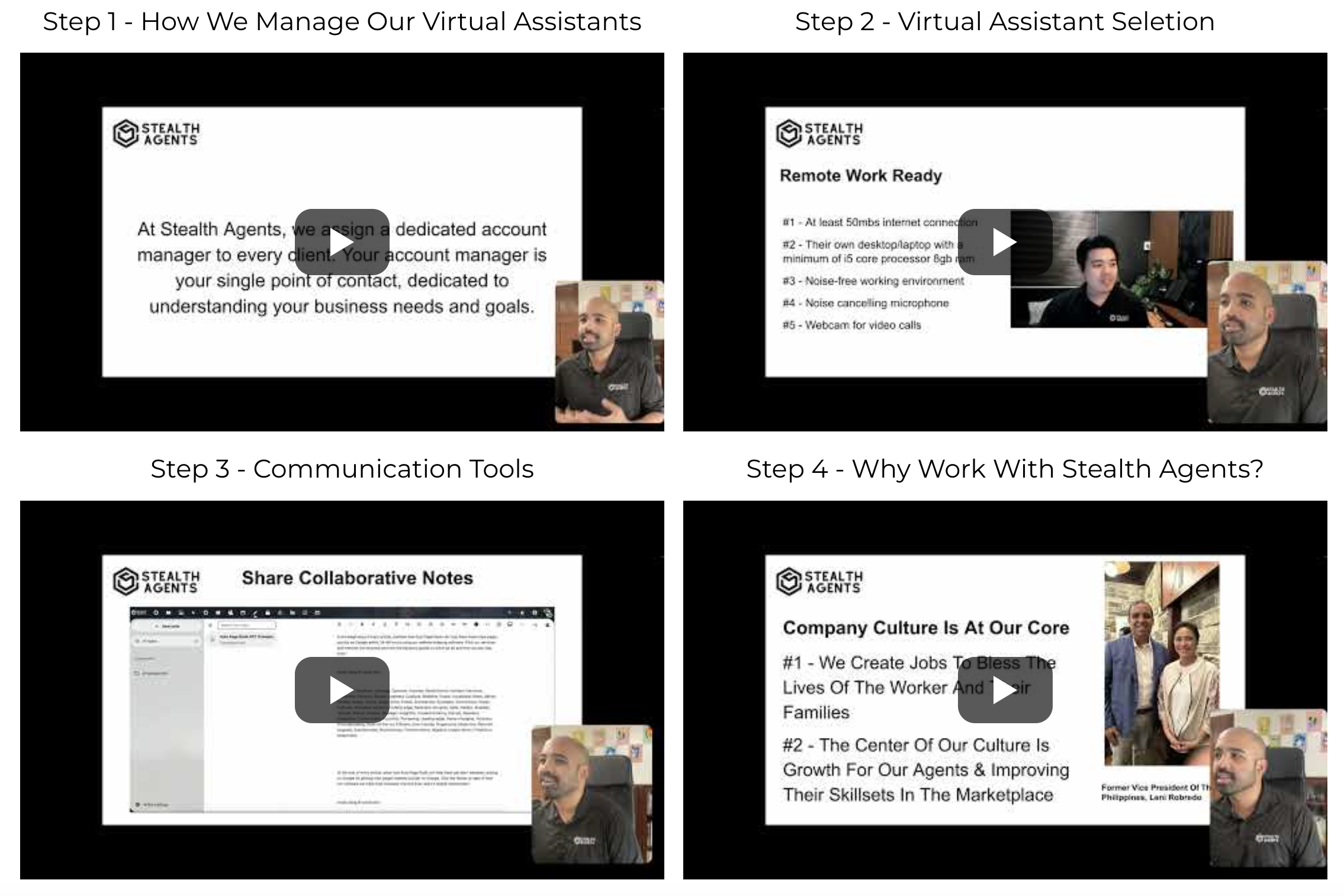Navigating the communication landscape can be challenging, but understanding the differences between Slack and Signal can simplify your decision.
Slack is a robust platform designed for team collaboration, integrating various tools to streamline workflow, making it ideal for businesses seeking efficient virtual assistant services.
On the other hand, Signal prioritizes privacy and secure messaging, appealing to users who value confidentiality over comprehensive integrations.
Virtual assistant pricing varies depending on the complexity and volume of tasks, and choosing the right communication tool can significantly impact efficiency.
Stealth Agents has meticulously compiled this resource to help you select the best platform for your organizational needs.
What is Slack?
Slack is a powerful collaboration hub designed to streamline communication within teams and organizations.
It offers a centralized platform where users can send messages, share files, and integrate numerous applications to enhance productivity.
*advertisement*
Tired & Overwhelmed With Administrative Tasks?
Hire A Top 1% Virtual Assistant From Stealth Agents!

Sign Up Below & Hire A Top 1% Virtual Assistant
Rated 4.7 Stars Serving Over 2,000+ Customers.
Hire Top 1% Virtual Assistants For $10-$15 Per Hour
Ask About Our 14 Day Trial!
*advertisement*
Primarily used by businesses, Slack allows for creating distinct channels for different projects or departments, ensuring organized and efficient communication.
Its user-friendly interface and extensive customization options make it adaptable to various business needs.
Slack helps teams maintain momentum and stay aligned on tasks and projects by facilitating real-time interaction.
Key Features:
- Channels: Organize talks according to subjects or divisions so that team members can concentrate on essential tasks without distraction.
- Integrations: Connect with over 2,000 apps, such as Google Drive, Trello, and Zoom, to streamline workflows and centralize tasks.
- File Sharing: Easily upload and share documents, images, and videos within conversations, ensuring all team members have access to necessary resources.
- Search Functionality: With a powerful search tool, quickly find past messages, files, and keywords, saving time and improving efficiency.
- Notifications: Customizable alerts help users stay informed about important messages and updates without overwhelming them with unnecessary information.
Pros:
- Enhanced Collaboration: Slack promotes open communication and transparency, allowing teams to work together more effectively and resolve issues quickly.
- User-Friendly Interface: Slack is appropriate for small teams and large businesses, and its various price options allow it to grow with any organization.
- Scalability: Slack is appropriate for small teams and large businesses, and its various price options allow it to grow with any organization.
- Security Measures: Slack protects sensitive information with features like data encryption and two-factor authentication.
- Mobile Accessibility: Slack allows team members to remain connected and productive even while on the go because it is available across various devices.
Cons:
- Over-Reliance on Notifications: The constant flow of messages can overwhelm users, leading to notification fatigue if not appropriately managed.
- Cost for Larger Teams: While Slack offers a free tier, the costs can add up quickly for larger teams requiring premium features.
- Limited Video Conferencing: Although Slack supports video calls, its functionality is limited compared to dedicated conferencing tools, requiring integrations for more robust features.
- Data Storage Limits: The free version restricts message history and file storage, which may necessitate upgrades for businesses with extensive data needs.
- Potential for Distraction: With numerous channels and integrations, users might need help with non-essential conversations and notifications.
What is Signal?
Signal is a highly secure messaging application prioritizes user privacy and data protection.
It guarantees the confidentiality of calls, media, and messages by providing end-to-end encryption for all communications.
With a straightforward and user-friendly interface, Signal is accessible to individuals and organizations and provides a reliable alternative to more mainstream platforms.
The app is open-source, allowing independent experts to verify its security measures, which bolsters trust among privacy-conscious users.
Signal’s commitment to transparency and security has made it a popular choice for those who value safeguarding their personal information.
Key Features:
- End-to-End Encryption: enhances privacy and security by ensuring that only the intended recipients can view your messages.
- Open Source: The code is publicly available for scrutiny, allowing independent audits to verify its security protocols.
- Cross-Platform Availability: Compatible with iOS, Android, and desktop, allowing seamless communication across devices.
- Secure Voice and Video Calls: This service provides encrypted voice and video calling, offering a secure communication channel for personal and professional use.
- Disappearing Messages: adds an additional degree of privacy by enabling users to select a timer for communications to be automatically deleted.
Pros:
- High-Level Security: Signal’s robust encryption practices protect user data from unauthorized access, making it ideal for privacy-focused users.
- User-Friendly Interface: The app is meant to be user-friendly and intuitive, so entire audiences can use it regardless of technological proficiency.
- No Ads or Tracking: Signal operates without advertisements or data tracking, maintaining user privacy and offering a distraction-free environment.
- Regular Updates: To ensure top speed and security, the software is updated often to fix security flaws and enhance functionality.
- Strong Community Support: Signal is an open-source platform That benefits from a community of developers and users who contribute to its ongoing improvement.
Cons:
- Limited Features Compared to Competitors: Signal must have some of the more sophisticated features available in other messaging apps, which may be a turnoff for some users even though it is secure.
- Requires Phone Number Registration: Users must provide a phone number to create an account, which might be a concern for those seeking complete anonymity.
- Dependent on Internet Connection: Signal requires a stable internet connection for messaging and calls, which can be limiting in areas with poor connectivity.
- Potential Learning Curve: While generally user-friendly, individuals new to encrypted communication might experience a slight learning curve when first using the app.
- Compatibility Issues: Some users report occasional compatibility issues with specific devices, requiring troubleshooting or updates to resolve.
Slack vs Signal: Detailed Features Comparison
1. User Interface: Customization and Ease of Use
Both platforms offer distinct user interfaces that cater to different needs and preferences compared to Slack vs Signal.
Slack provides a highly customizable workspace, allowing users to tailor their experience with numerous themes and layouts.
Conversely, Signal focuses on simplicity and minimalism, providing an intuitive interface that emphasizes straightforward communication.
While Slack’s interface is designed for professional collaboration with channels and threads, Signal prioritizes direct messaging and end-to-end encrypted chats.
Ultimately, your choice between Slack and Signal for the user interface depends on whether you need a richly featured workspace or a clean, straightforward messaging app.
2. Security: Protecting Your Conversations
In the ongoing debate of Slack vs Signal, security features remain crucial for users prioritizing privacy, especially those utilizing a cybersecurity virtual assistant.
Signal is acclaimed for its strong security measures, providing end-to-end encryption that ensures messages are accessible solely to intended recipients.
While Slack offers encryption both in transit and at rest, it lacks end-to-end encryption, which might be crucial for managing susceptible communications.
Signal’s open-source protocol enhances transparency through regular security audits, building trust among its users.
If security is paramount for those with a cybersecurity virtual assistant, Signal may be the more suitable option for protecting your conversations.
3. Integrations: Expanding Functionality through Third-Party Apps
Regarding Slack vs Signal regarding integrations, Slack stands out with its extensive range of third-party app integrations designed to enhance productivity.
Slack offers hundreds of integrations with popular business tools like Google Workspace, Trello, and Salesforce, providing seamless connectivity and efficiency in workflow management.
Signal, however, maintains a focus on core messaging features, offering limited integration options primarily to preserve its security-first approach.
For organizations seeking a robust platform that integrates with essential business applications, Slack provides a comprehensive solution.
Therefore, Slack vs Signal’s choice hinges on prioritizing either integration versatility or a streamlined, secure communication tool.
4. Pricing: Evaluating Cost for Value
The Slack vs Signal discussion also encompasses the pricing models each platform offers its users.
Slack provides a tiered pricing structure, starting with a free version with essential features and paid plans that unlock advanced functionalities and more excellent user management controls.
Signal, in contrast, is a free application funded by donations and grants, ensuring all features are accessible without cost.
Organizations considering the financial aspect, Slack vs Signal might opt for Slack’s paid plans for enhanced capabilities or Signal’s free service for budget-friendly communication.
Your decision in Slack vs Signal pricing should reflect your budget and the value you place on advanced features.
5. User Base: Understanding Who Uses Each Platform
An essential aspect of the Slack vs Signal comparison is understanding the user base and typical applications for each platform.
Slack is widely adopted by businesses and teams for professional and collaborative work environments, supporting a diverse range of industries.
This inclusivity means that regardless of your industry or team size, Slack can cater to your communication needs.
Signal, on the other hand, tends to attract users who prioritize privacy and secure communications, including activists, journalists, and individuals circumventing surveillance.
The Slack vs Signal choice may depend on whether your focus is on team productivity and workplace collaboration or on private, secure communications for personal or sensitive use.
Ultimately, recognizing the distinct user communities can guide an informed choice tailored to your communication needs.
How Stealth Agents Choose Slack vs Signal?
Stealth agents often face the challenge of selecting between Slack and Signal, depending on their communication and security needs.
Many agents lean towards Signal when prioritizing confidentiality due to its robust end-to-end encryption, which aligns well with their mission of maintaining secrecy.
In contrast, Slack offers a more collaborative environment, making it appealing when agents need to coordinate complex operations across different teams.
The presence of an information security virtual assistant can significantly influence this choice, as it helps evaluate the platforms’ capabilities in protecting sensitive data.
Additionally, a security system virtual assistant can aid agents by providing insights into real-time threats, ensuring that their chosen platform remains secure and trustworthy.
For stealth agents, the delicate balance between effective communication and stringent security measures is crucial.
Both virtual assistants play a pivotal role in this decision-making process, ensuring that the chosen platform meets their operational needs.
Ultimately, the choice between Slack vs Signal is determined by each agent’s unique operational requirements and the level of security assurance demanded.
There isn’t a single answer that works for everyone, so thoughtful thought is required.
Conclusion
In evaluating Slack vs Signal, it’s evident that each platform offers unique benefits tailored to different communication needs.
Slack shines in environments requiring collaboration and integration, enhancing productivity through numerous features despite often demanding more hours worked to manage its diverse tools.
Signal, however, prioritizes privacy and simplicity, ideal for those who value secure and direct communication without the need for extensive integrations.
The choice between Slack vs Signal ultimately hinges on whether your primary focus is enhancing productivity through comprehensive collaboration tools or safeguarding privacy with straightforward communication.
Understanding the balance between productivity vs hours worked helps guide users in selecting the platform that best suits their operational requirements and security preferences.










